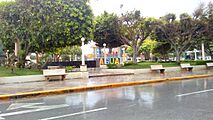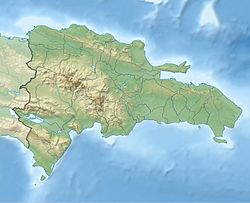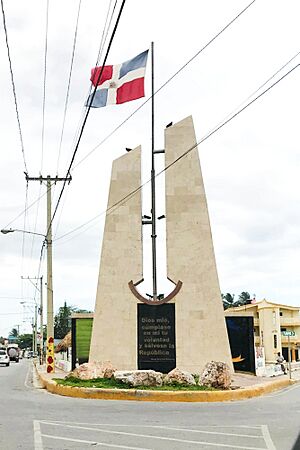Nagua facts for kids
Quick facts for kids
Nagua
|
||
|---|---|---|
|
Municipality
|
||
|
Clockwise from top: Main square, statue of Juan Pablo Duarte, Students of Nagua, Maria Trinidad Sanchez monument.
|
||
|
||
| Country | ||
| Province | María Trinidad Sánchez | |
| Municipality since | 1938 | |
| Area | ||
| • Total | 552.71 km2 (213.40 sq mi) | |
| Elevation | 3 m (10 ft) | |
| Population
(2012)
|
||
| • Total | 79,420 | |
| • Density | 143.692/km2 (372.161/sq mi) | |
| Distance to – Santo Domingo |
170 km |
|
| Municipal Districts | 3 | |
| Climate | Af | |
Nagua is a city in the northeastern Dominican Republic. It is the capital of the María Trinidad Sánchez province.
Nagua is a medium-sized city. Its economy mostly depends on farming. They grow products like rice, coconuts, and cocoa beans. The city is located north of the Samaná Peninsula. It sits on the main highway that connects Puerto Plata to the city of Samaná.
Contents
History of Nagua
Early Beginnings as a Fishing Village
The area where Nagua is today started as a small fishing village in the 1800s. It had just two rows of houses built close to the bay. Most of these homes were made of wood.
The people of this village, called nagüeros, relied on a town named Matanzas. Matanzas was the main center for trade, government, and politics. It served the entire area between Sosúa and Puerto Plata in the north, and Samaná in the northeast.
Matanzas and the Earthquake
San José de Matanza was an older town. It had a busy pier that helped with trade across the country.
However, a big earthquake in 1946 caused a lot of damage. The people of Matanzas had to move. They settled permanently in the area that is now Nagua. More than 100 families moved there. They brought their customs and traditions, which helped Nagua grow and develop.
Where Nagua is Located
Most of Nagua is actually below sea level. Some people worry this makes the city vulnerable to floods. A major flood could cause a lot of damage.
This concern comes from what happened in 1946. During the time of Rafael Trujillo, a powerful earthquake hit. It caused severe flooding that destroyed the nearby town of Matanza. Matanza was also below sea level. Many people from Matanza moved to what is now Nagua after this disaster. Today, Matanza is a small town called Matancita, just south of Nagua.
Nagua's Climate
Nagua has a tropical rainforest climate. This means it is generally hot and humid all year round. It also gets a lot of rain.
| Climate data for Nagua (1961-1990) | |||||||||||||
|---|---|---|---|---|---|---|---|---|---|---|---|---|---|
| Month | Jan | Feb | Mar | Apr | May | Jun | Jul | Aug | Sep | Oct | Nov | Dec | Year |
| Record high °C (°F) | 35.0 (95.0) |
34.4 (93.9) |
35.2 (95.4) |
35.2 (95.4) |
36.8 (98.2) |
37.0 (98.6) |
36.4 (97.5) |
35.5 (95.9) |
37.6 (99.7) |
35.6 (96.1) |
35.3 (95.5) |
33.6 (92.5) |
37.6 (99.7) |
| Mean daily maximum °C (°F) | 28.5 (83.3) |
28.9 (84.0) |
29.5 (85.1) |
29.9 (85.8) |
30.2 (86.4) |
30.8 (87.4) |
30.8 (87.4) |
31.0 (87.8) |
31.3 (88.3) |
30.8 (87.4) |
29.8 (85.6) |
28.8 (83.8) |
30.0 (86.0) |
| Mean daily minimum °C (°F) | 20.1 (68.2) |
20.2 (68.4) |
20.6 (69.1) |
21.0 (69.8) |
21.5 (70.7) |
22.2 (72.0) |
22.2 (72.0) |
22.5 (72.5) |
22.6 (72.7) |
22.3 (72.1) |
21.7 (71.1) |
20.5 (68.9) |
21.5 (70.7) |
| Record low °C (°F) | 12.6 (54.7) |
14.0 (57.2) |
15.9 (60.6) |
15.9 (60.6) |
16.7 (62.1) |
16.0 (60.8) |
17.0 (62.6) |
17.0 (62.6) |
17.1 (62.8) |
17.1 (62.8) |
15.7 (60.3) |
11.8 (53.2) |
11.8 (53.2) |
| Average rainfall mm (inches) | 137.9 (5.43) |
97.2 (3.83) |
99.2 (3.91) |
146.0 (5.75) |
230.3 (9.07) |
111.7 (4.40) |
118.0 (4.65) |
155.3 (6.11) |
146.1 (5.75) |
216.1 (8.51) |
253.6 (9.98) |
214.9 (8.46) |
1,926.3 (75.84) |
| Average rainy days (≥ 1.0 mm) | 11.5 | 8.9 | 7.6 | 9.0 | 12.5 | 9.3 | 11.4 | 12.8 | 11.7 | 13.3 | 15.3 | 14.6 | 137.9 |
| Source: NOAA | |||||||||||||
Nagua's Economy
The economy of Nagua mainly relies on farming. The most important crops grown here are:
- rice
- coconuts
- cocoa
- peanuts
- oranges
- root vegetables
There are also many farms that raise cattle for dairy. These farms have thousands of cows and produce a lot of milk every day.
How People Help the Economy
Many people from Nagua move to other places for work. When they send money back home, it helps the local economy. This money has led to new buildings and businesses in recent years.
Also, many banks have opened branches in Nagua. This helps with money flow and investments. Local business owners also contribute by opening factories, pharmacies, and other shops.
Tourism Potential
Nagua has a long coastline with beautiful beaches. This makes it a great place for building hotels and restaurants. Developing tourism can help bring more visitors and boost the local economy even further.
Famous People from Nagua
Nagua is the birthplace of several notable people, including:
- Ubaldo Jiménez: A famous pitcher who played for the Baltimore Orioles in baseball.
- Jordan Norberto: Another pitcher who played for the Oakland Athletics.
- Yairo Muñoz: A versatile baseball player for the St. Louis Cardinals.
- Cieguito de Nagua (Bartolo Alvarado): A musician known for playing merengue and bachata music.
- Nolito de Nagua Chap: A musician famous for his Haitian music.
- Tatico Henriquez: Many consider him the "godfather" of merengue tipico, a traditional style of merengue music.
See also
 In Spanish: Nagua para niños
In Spanish: Nagua para niños









